Masterpiece Story: Dynamism of a Dog on a Leash by Giacomo Balla
Giacomo Balla’s Dynamism of a Dog on a Leash is a masterpiece of pet images, Futurism, and early 20th-century Italian...
James W Singer, 23 February 2025
2 March 2025 min Read
The story of Frida Kahlo is narrated through her artworks. She left an indelible mark on the art world with her emotionally charged and autobiographical works. Among her 143 paintings, 55 are self-portraits, and the first one was painted in 1926 when she was only 19 years old. Starting her artistic journey out of the necessity to fill time and as a means of self-therapy, it gradually became something much more significant.
Kahlo painted herself because that was what she knew best and, in those faces, she captured her ideology, her intimate world filled with symbolism, creating masterpieces such as Self-Portrait with Thorn Necklace and Hummingbird.
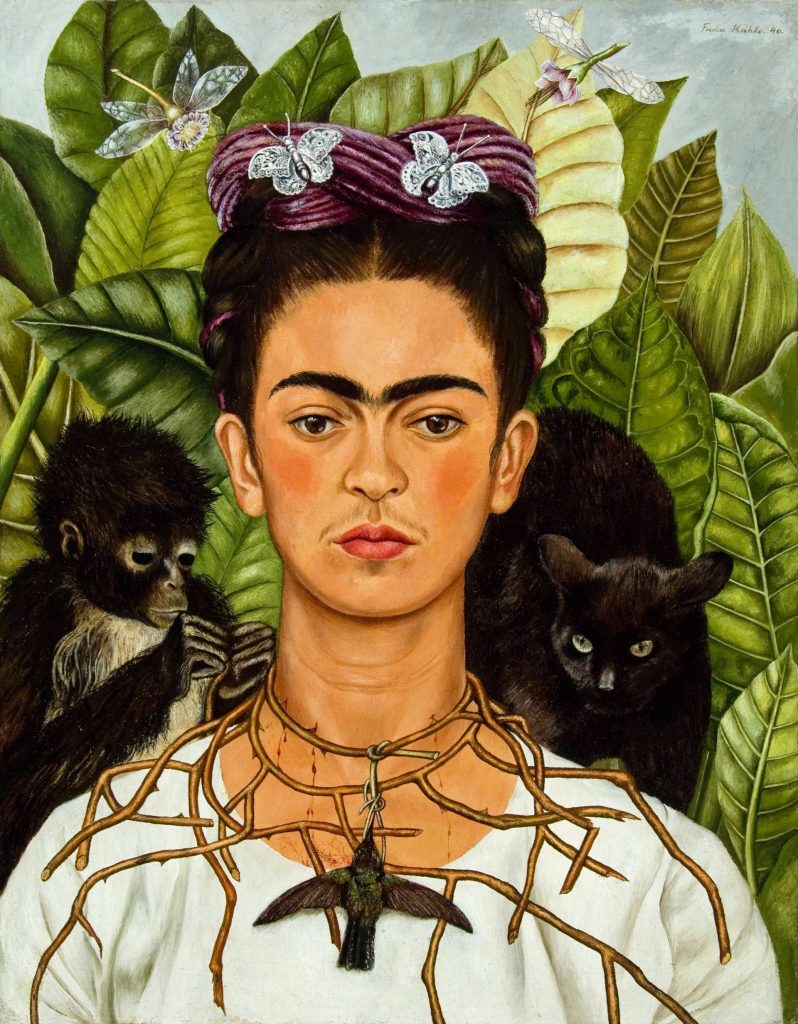
Frida Kahlo, Self-Portrait with Thorn Necklace and Hummingbird, 1940, Harry Ransom Center, Austin, TX, USA.
Among all her self-portraits, perhaps this is one of the most well-known. In it, we see a serious Frida Kahlo, which is the focal point of the painting, looking directly at us – which is the way we usually see her in her paintings. Dressed in a white shirt, she wears a thorn necklace that draws blood from her neck, while an inverted black hummingbird hangs from it. Perched on her shoulders, two animals rise: to her left, a threatening black cat arching its back, and to her right, a monkey that, focused, fiddles with her necklace. Above her head, we see a headdress topped with two butterflies that seem to be made of glass. Each of them looks at two beautiful small flowers with transparent wings that frame the portrait. In the background, vegetation rises, its branches of intense green contribute to the piece’s iconic color palette.
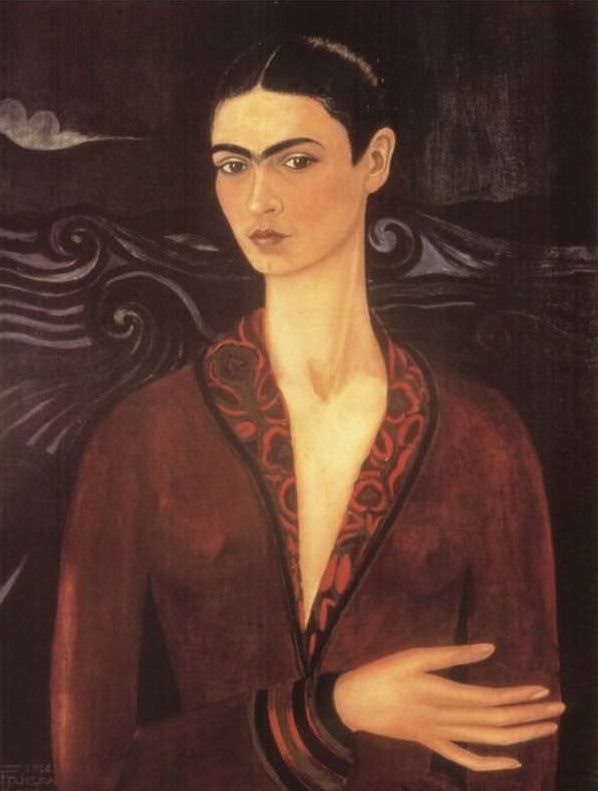
Frida Kahlo, Self Portrait in a Velvet Dress, 1926, private collection, Mexico City, Mexico.
Self-Portrait in a Velvet Dress stands as one of Frida Kahlo’s earliest paintings—a first self-portrait that is also considered to be her first professional painting.
Understanding the symbolism within Self-Portrait with Thorn Necklace and Hummingbird, requires exploring its context. At the time of its creation, Frida and Diego had just divorced after being separated for some time. After a relationship known for its passion, affairs, and ups and downs, Frida was devastated by the separation. In fact, Diego initiated the process, leading to Frida’s emotional turmoil and solitude alongside a deterioration of her health.
Let’s consider now the most the attributes that immediately come to mind when thinking about Frida Kahlo’s artworks. Is it her gaze, always framed by her iconic eyebrows? Or perhaps her mouth, with its ever-present mustache? In this small-format masterpiece, Frida Kahlo condenses a myriad of symbols from her imagination, while she uses a very vivid and vibrant color palette and each element echoes her situation, providing insights into her thoughts.

Detail, Frida Kahlo, Self-Portrait with Thorn Necklace and Hummingbird, 1940, Harry Ransom Center, Austin, TX, USA.
Although Christian and Aztec elements can be observed in the piece, the main focus always remains on herself. Firstly, while the thorn necklace, reminiscent of Jesus’s crown of thorns, transforms her into a martyr, the butterflies symbolize resurrection. Secondly, the lifeless hummingbird on her chest signifies desolation after her separation from Diego Rivera and also represents Huitzilopochtli, the Aztec god of war.
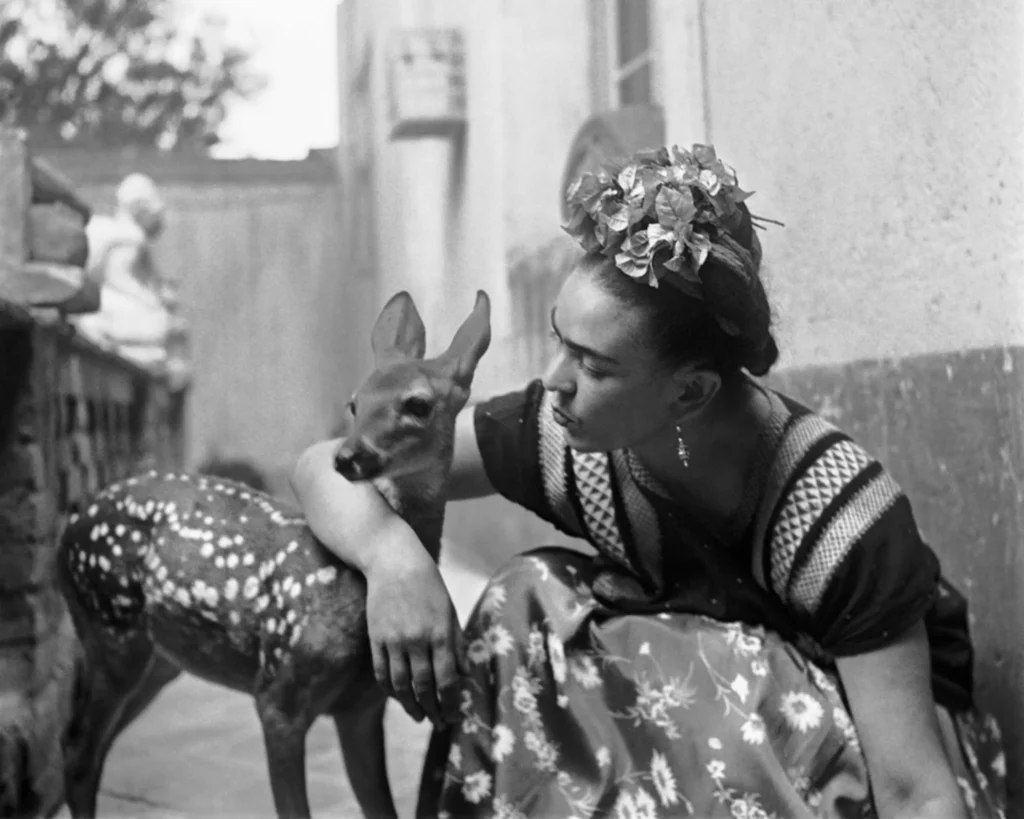
Nickolas Muray, Frida with Granizo, Version 2, Coyoacan, 1939, PDNB Gallery
It is known that Frida Kahlo had quite a few pets throughout her life. These animals often make appearances in her portraits – to be more specific, they appear in 55 of the 143 paintings she created in her lifetime. In the case of this masterpiece, while we know that the black cat is commonly associated with bad luck and, therefore, its presence may symbolize the ominous shadows cast over Kahlo’slife, the presence of the monkey sparks various interpretations.
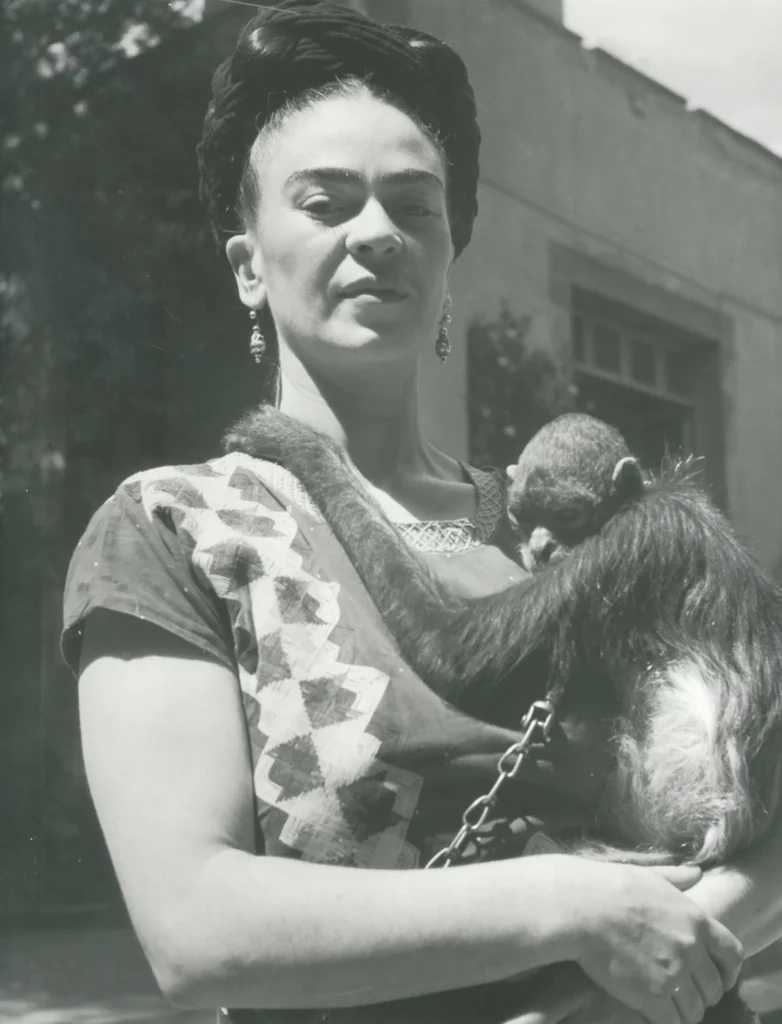
Fritz Henle, Frida in Front of Studio with Monkey, Coyoacan, 1946, Bentley Gallery
Kahlo had two spider monkeys: one of them was a gift from Diego Rivera, named Fulang Chang, and the other Caimito de Guayabal. In fact, monkeys appear in many of her portraits. While in Mexican mythology, monkeys are symbols of lust, Kahlo usually portrayed them as tender and protective symbols. A few years after this piece, Kahlo painted a Self-portrait with monkeys, a much gentler version of this self-portrait where negative elements disappear to make way for a Frida surrounded by four friendly primates. In this case, the monkeys interact directly with her: they embrace and caress her.
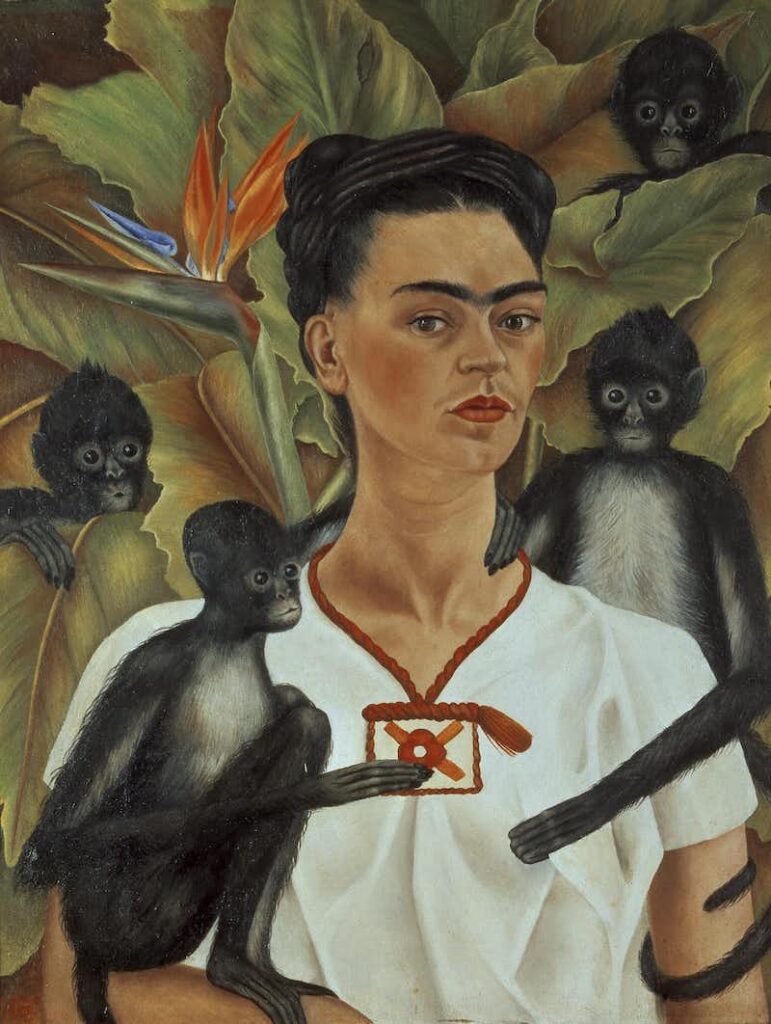
Frida Kahlo, Self Portrait with Monkeys, 1943, the collection of Jacques and Natasha Gelman, Mexico City, Mexico.
According to the painter, these animals represent the children she could never have. However, in the piece at hand, the monkey on her back has a more negative connotation and is often seen as a reference to Diego Rivera. As he plays with her necklace, it suggests a connection to the complexities of her personal life. In any case, the monkeys are undeniably companions in Frida’s solitude.
The dense jungle backdrop conveys both vitality and entrapment, mirroring Frida’s contradictions – a life brimming with vitality but constrained by physical and emotional pain. The vibrant surroundings affirm her connection to Mexican heritage and resistance against colonial forces.
Frida’s deep connection to Mexicanidad, a movement promoting indigenous Mexican culture, is evident in her choice of clothing and symbols. Beyond personal pain, her self-portraits also reflect the political and social reforms occurring in Mexico during her lifetime. Through her art, Frida voiced concerns for her country’s quest for an independent cultural identity.
Self-Portrait with Thorn Necklace and Hummingbird confines the essence of Frida Kahlo’s art – a poignant expression of pain, resilience, and cultural pride. Beyond being a form of self-therapy and a medium for expressing her pain, life, and emotions, Frida’s art served as a tool to forge a new identity.
Art, surpassing mere representation, possesses the ability to construct novel worlds through fiction. Frida Kahlo depicted herself, drawing lessons from her own existence, and sculpted a fresh iteration of herself in each of her portraits. To achieve this, she forged her unique symbology and vocabulary, now emblematic, crafting the image of a 20th-century painter who has indelibly shaped not only the annals of art history but also emerged as a symbol of womanhood—both Latin American and universal—and a feminist icon.
Kahlo, Andrea Kettenmann, 2016, TASCHEN Books
DailyArt Magazine needs your support. Every contribution, however big or small, is very valuable for our future. Thanks to it, we will be able to sustain and grow the Magazine. Thank you for your help!